- Massive Environmental Impact: Historically, construction has been a significant contributor to pollution, waste, and resource depletion, consuming vast amounts of materials and energy.
- Technological Evolution: Advances like BIM, smart building systems, and modular construction are fundamentally changing how buildings are designed and erected, leading to reduced environmental harm.
- Sustainable Materials & Practices: A strong industry shift towards eco-friendly materials, circular economy principles, and net-zero designs is paving the way for a more responsible built environment.
As construction people, we've all felt that thrill of seeing a blueprint come to life, transforming a concept into a tangible structure. But let's be honest, the journey from an empty plot to a finished building hasn't always been kind to our planet. For a long time, construction was a major player in environmental degradation, consuming resources at an alarming rate and leaving a trail of waste and pollution. However, the good news is, things are changing. The industry is evolving, embracing new technologies and more efficient methods to build smarter and greener.
The Environmental Footprint: What Construction Leaves Behind
Understanding the Broad Impacts of Building Activity
The construction industry's impact on the environment is wide-ranging, touching everything from the air we breathe to the water we drink. It's not just about the big cranes and noisy demolition; it's a complex web of resource extraction, energy consumption, and waste generation.
Air Pollution: More Than Just Dust
Construction sites are notorious for kicking up dust, and that's just the start. Exhaust from diesel-powered machinery, fumes from chemicals, and emissions from transportation all contribute to air pollution. Globally, construction accounts for a significant portion of air pollution. Imagine all those excavators and trucks, working tirelessly, but also releasing a cloud of harmful particles and gases. This impacts air quality for workers and nearby communities, affecting public health.

Visible air pollution from a construction site, a common environmental challenge.
Water Pollution: A Murky Problem
Construction activities can lead to serious water contamination. Rainwater runoff from sites often carries soil, debris, paints, solvents, and other toxic chemicals into drains, rivers, and even drinking water sources. This isn't just an eyesore; it harms aquatic life and can make water unsafe for human consumption. It's like a muddy, oily river flowing from the site, impacting ecosystems far beyond the construction boundaries.
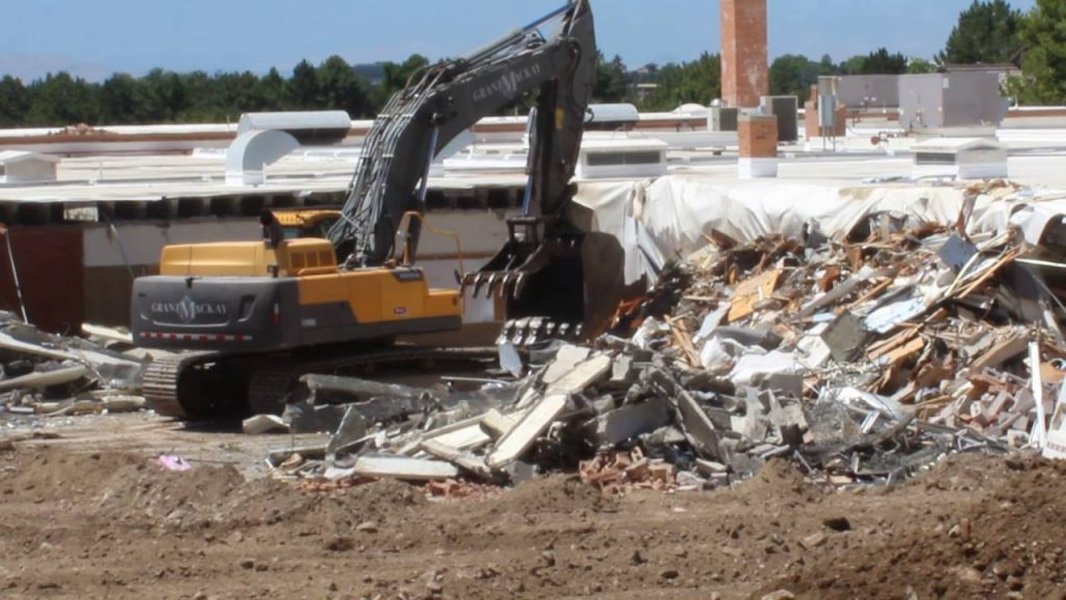
Runoff from a construction site, a source of water contamination.
Waste Generation: A Mountain of Debris
The construction industry is a major contributor to landfills. From leftover materials and packaging to demolition debris, the amount of waste generated is immense. This isn't just an aesthetic problem; it depletes valuable landfill space and represents a massive loss of potentially reusable resources. Think about all the scraps of wood, concrete, and metal that end up in the dump—it's a literal mountain of waste that could have been given a second life.
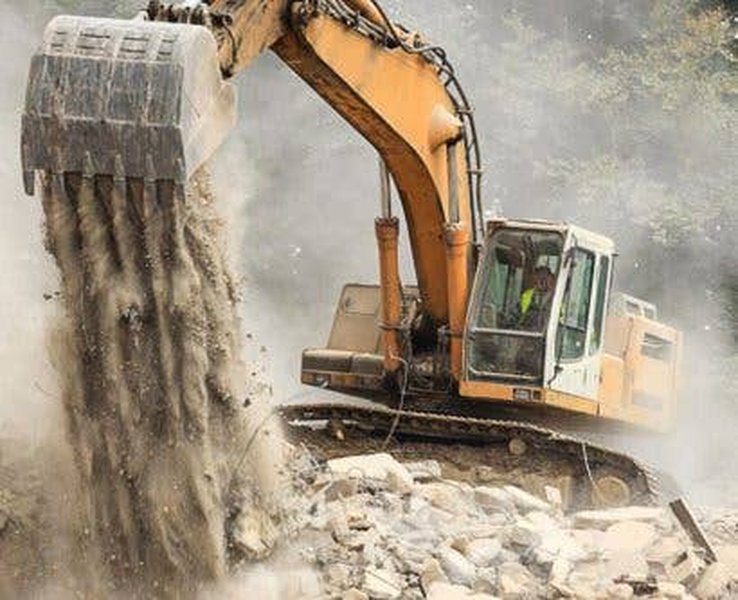
A substantial pile of construction waste, a common sight on many building sites.
Resource Consumption: The Earth's Appetite
Buildings are material-intensive. Steel, cement, wood, sand, glass – extracting and processing these resources demands a huge amount of energy and can lead to deforestation, habitat loss, and depletion of natural reserves. Cement production, for example, is a significant source of carbon emissions due to the chemical reactions involved and the energy required. It's a continuous demand that strains our planet's natural systems.
Energy Consumption and Greenhouse Gases
The entire construction lifecycle, from manufacturing materials to operating buildings, is energy-hungry. This energy often comes from fossil fuels, contributing heavily to greenhouse gas emissions and climate change. It's a significant portion of global energy consumption and a primary driver of carbon dioxide in the atmosphere.
Habitat Destruction and Land Degradation
Before any structure can rise, land often needs to be cleared. This process can destroy natural habitats, displace wildlife, and disrupt ecosystems. Building on undeveloped land can also lead to soil erosion and contamination, fundamentally altering the natural landscape.
A Historical Shift: From "Build Now, Worry Later" to "Build Smart, Build Green"
How the Industry Learned to Adapt
It wasn't always about sustainability. Back in the day, especially in the early 20th century, construction was largely about brute force and speed. The Empire State Building, for instance, went up incredibly fast in 410 days, but with little regard for the environmental consequences, leaving behind a carbon footprint of coal smoke. Efficiency then meant getting things done quickly, not cleanly.
The mid-20th century saw an explosion in concrete and steel use, driven by post-war booms. While this allowed for rapid expansion, it also escalated issues like deforestation and increased demand for mining. Environmental concerns slowly started to surface, leading to the introduction of regulations like clean air acts in the 1970s and 80s, forcing some initial changes in materials and practices.
The real game-changer came with the digital revolution. The 1990s and 2000s brought us CAD software, which allowed for more precise designs and reduced material waste. GPS technology on machinery meant more accurate excavation, leading to less unnecessary earth movement. These tools started pushing efficiency beyond mere speed, hinting at a greener future.
Modern Marvels: Technology and Efficiency Leading the Charge
The New Era of Sustainable Construction
Today, heading into 2025, the construction landscape is radically different. Sustainability isn't a buzzword; it's a core principle. Technology is no longer just about speeding things up; it's about making them smarter, cleaner, and more efficient.
Smart Building Systems: Buildings That Think
Imagine a building that can sense its environment and adjust accordingly. That's what smart building systems do. Using the Internet of Things (IoT), Artificial Intelligence (AI), and cloud computing, these systems monitor everything from energy and water usage to air quality. They can optimize heating, ventilation, and lighting in real-time, drastically reducing operational energy consumption. This kind of intelligence helps buildings move towards net-zero emissions, adjusting lights when no one's around or regulating temperature based on occupancy.
Building Information Modeling (BIM): The Digital Blueprint for Sustainability
BIM has transformed how projects are conceived and executed. It's a digital tool that allows architects, engineers, and contractors to collaborate on a single, integrated model. This helps in detecting clashes early, optimizing material usage, and planning logistics more efficiently. For us designers, BIM is a powerful ally, helping to design out waste and integrate sustainable features from the very beginning. Tools like Autodesk Construction Cloud and Procore offer collaboration, but a designer-focused approach integrates sustainability from sketch one, which is our priority.
Modular and Off-Site Construction: Building Like Lego
This method involves manufacturing building components or even entire modules in a factory setting, then assembling them on-site. Think of it like building with giant Lego pieces. This approach dramatically reduces waste (by up to 90% in some cases) due to precise factory control. It also leads to faster construction times, fewer deliveries to the site (meaning less traffic and emissions), and improved quality control. It's a game-changer for efficiency and environmental impact. Companies like Autovol are even using this for affordable housing, faster and with less waste.
Sustainable Building Materials: Beyond Concrete
The materials we choose have a huge impact. There's a growing movement towards eco-friendly alternatives with lower environmental footprints. This includes recycled steel, bamboo, low-carbon concrete, and innovative bio-based materials like mycelium bricks, straw panels, and hemp solutions. These materials not only reduce waste but also decrease the embodied carbon (emissions from production and transport) of a project. For instance, swapping out a portion of traditional Portland cement for fly ash or slag can significantly cut CO2 emissions.
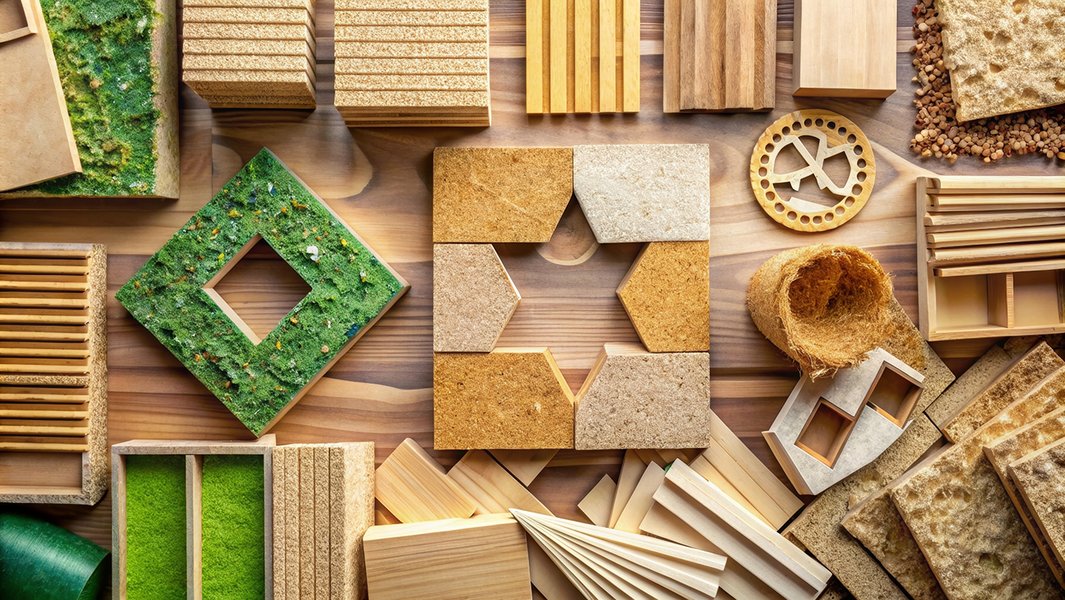
A selection of sustainable building materials, reflecting the industry's shift towards greener options.
Circular Economy Principles: Nothing Goes to Waste
The idea here is to keep materials in use for as long as possible. This means designing buildings for easy disassembly, promoting the reuse of components, and diligently recycling construction and demolition waste. It's about minimizing the "take-make-dispose" linear model and creating a system where materials cycle back into production.
3D Printing in Construction: Precision Building
3D printing is emerging as a way to construct building components, and even entire structures, with minimal material waste. This technology allows for precise application of materials, reducing excess and speeding up the construction process. It also opens doors for using sustainable materials in new ways.
Drones and AI for Site Management
Drones are used for site surveying, monitoring progress, and inspections, providing accurate data and reducing the need for human presence in dangerous areas. AI can analyze this data to predict maintenance needs, optimize workflows, and even identify potential environmental risks, making sites more efficient and less wasteful.
The Future is Green: Trends Shaping Construction in 2025 and Beyond
Looking Ahead: Net-Zero and Regenerative Practices
The industry is not standing still. The focus is increasingly on achieving net-zero energy buildings (NZEB), which produce as much energy as they consume, often through on-site renewable sources like solar panels. Some are even aiming for net-positive buildings, which generate more energy than they use. Countries like Canada are developing building codes for 2025 and 2030 to push towards these net-zero standards.
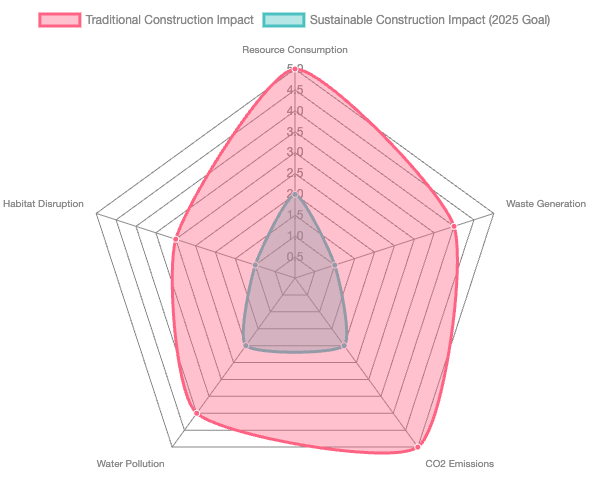
This radar chart illustrates the comparative environmental impact of traditional construction versus the ambitious goals for sustainable construction in 2025. Lower scores on the radar indicate reduced environmental impact across various categories, highlighting the significant progress targeted by green building initiatives.
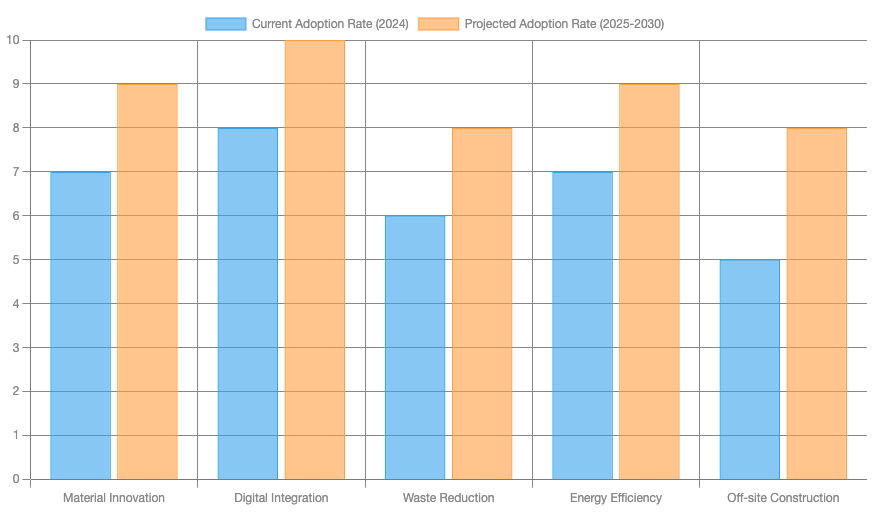
This bar chart compares the current adoption rates (2024) of key sustainable construction technologies and practices with their projected adoption rates for 2025-2030. The increase in projected adoption highlights the industry's commitment to integrating advanced solutions for greater environmental responsibility and efficiency.
The Interconnectedness of Modern Construction
Mapping the Key Elements for a Sustainable Future
The shift towards sustainable construction isn't just about individual technologies; it's about how all these elements connect and influence each other. Think of it as a mindmap where every idea supports and strengthens the others, creating a holistic approach to building.
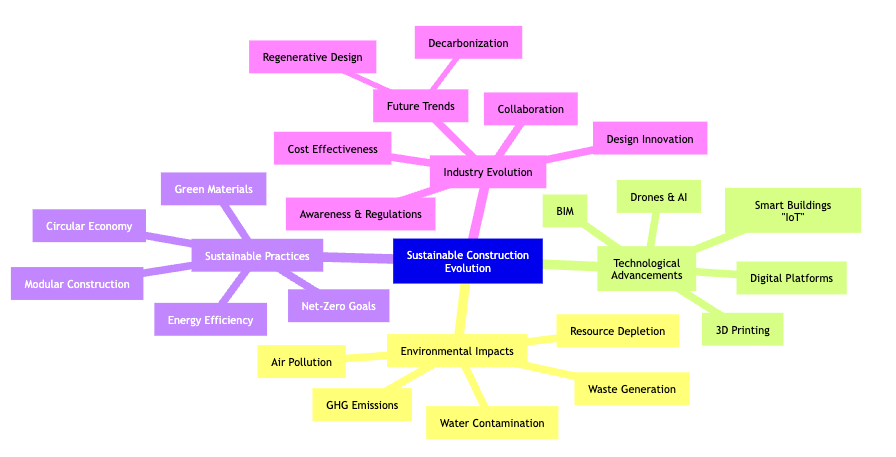
This mindmap illustrates the complex interplay between the environmental impacts of construction, the technological advancements addressing these issues, and the sustainable practices driving the industry's evolution. It highlights how various factors are interconnected, leading towards a more responsible and efficient built environment.
Key Elements of Sustainable Building: A Comparison
From Traditional to Transformative: A Shift in Focus
To truly appreciate the transformation, let's look at how various aspects of construction have evolved, comparing older practices with today's sustainable approaches.
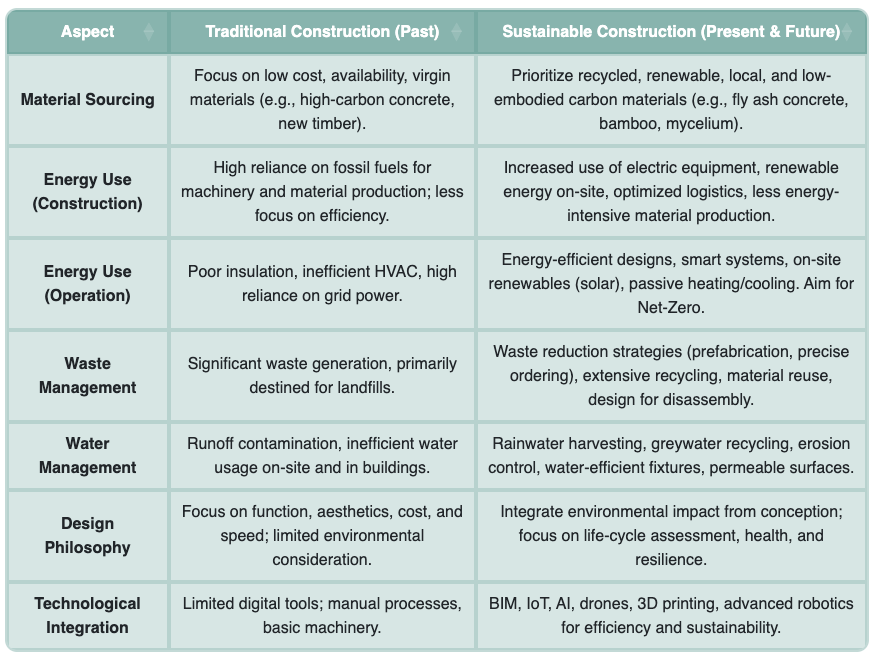
Case Studies: Sustainability in Action
Real-World Examples of Green Building
- The Edge Building, Amsterdam: Often cited as one of the smartest and most sustainable office buildings globally. It uses solar panels, smart lighting, and an advanced heating and cooling system to minimize energy consumption. It even incorporates recycled materials and has achieved top green certifications.
- 3D Printed Houses, Texas: Non-profit organizations have used 3D printing to construct affordable homes quickly, using less material and producing minimal waste compared to traditional methods.
- Green Buildings in Canada: Many residential and commercial projects in Canada are achieving high LEED or BREEAM certifications by incorporating energy-efficient designs, renewable energy systems, and sustainable materials, often consuming significantly less energy than conventional buildings.
- Modular Construction for Housing: Several companies are now using modular construction to rapidly build affordable housing, completing projects in a fraction of the time with substantial reductions in waste and energy use.
Challenges and the Road Ahead
Navigating Obstacles on the Path to a Greener Future
Despite incredible progress, the journey isn't without its bumps. High initial costs for sustainable materials and technologies can be a barrier. There's also a need for greater awareness and education among all stakeholders – from clients to policymakers – about the long-term benefits of green construction. Regulatory frameworks sometimes lag behind innovation, and supply chain issues for sustainable materials can pose challenges.
However, the future remains bright. The industry is moving towards a more circular and even regenerative model, where buildings not only minimize harm but actively contribute to environmental restoration. For us designers, the opportunity lies in embracing these changes, pushing for integrated sustainable solutions, and ensuring that our blueprints contribute to a healthier planet.
Frequently Asked Questions (FAQ)
What is embodied carbon in construction?
Embodied carbon refers to the greenhouse gas emissions associated with the materials and construction processes of a building throughout its entire life cycle, including extraction, manufacturing, transportation, installation, and end-of-life disposal or recycling.
What are Net-Zero Energy Buildings (NZEB)?
Net-Zero Energy Buildings are structures designed to produce as much renewable energy on-site as they consume over the course of a year, resulting in a net-zero carbon footprint from their operation.
How do smart building technologies reduce environmental impact?
Smart building technologies use sensors, IoT devices, and AI to optimize energy use for lighting, heating, cooling, and ventilation based on real-time data and occupancy, significantly reducing overall energy consumption and emissions.
What is the circular economy's role in construction?
The circular economy in construction aims to keep resources in use for as long as possible by designing buildings for disassembly, reusing materials, and recycling construction and demolition waste, thereby minimizing resource depletion and landfill waste.
Are sustainable building materials more expensive?
While some sustainable materials may have higher upfront costs, they often lead to long-term savings through reduced energy consumption, lower maintenance, and potential green building incentives, offering a better return on investment over the building's lifespan.
Conclusion
The construction industry has historically imposed a heavy burden on the environment, marked by significant resource consumption, waste generation, and pollution. However, we are witnessing a profound transformation. Driven by growing environmental awareness and rapid technological advancements, the industry is moving decisively towards more sustainable practices. From the intelligent integration of smart building systems and BIM, to the adoption of modular construction and innovative green materials, every aspect of building is being re-evaluated through an ecological lens.
This evolution is not merely a trend but a fundamental shift towards a built environment that not only minimizes harm but actively contributes to the planet's well-being. While challenges remain, the commitment to net-zero goals, circular economy principles, and regenerative design marks a promising future. As designers, we are at the forefront of this change, empowered with tools and knowledge to craft structures that are not only functional and beautiful but also responsible stewards of our planet. The path forward is clear: to build smarter, greener, and more harmoniously with nature.
References
[PDF] 2025 Sustainable Construction Barometer - Saint-Gobain
16 sustainable and cost-effective building materials
Built Environment - an overview | ScienceDirect Topics
Technologies Used in Sustainable Construction - Claris Design Build
A little can go a long way in reducing construction's environmental impact | CIC Construction Group
Sustainable building trends: what will 2025 bring and how was 2024?















